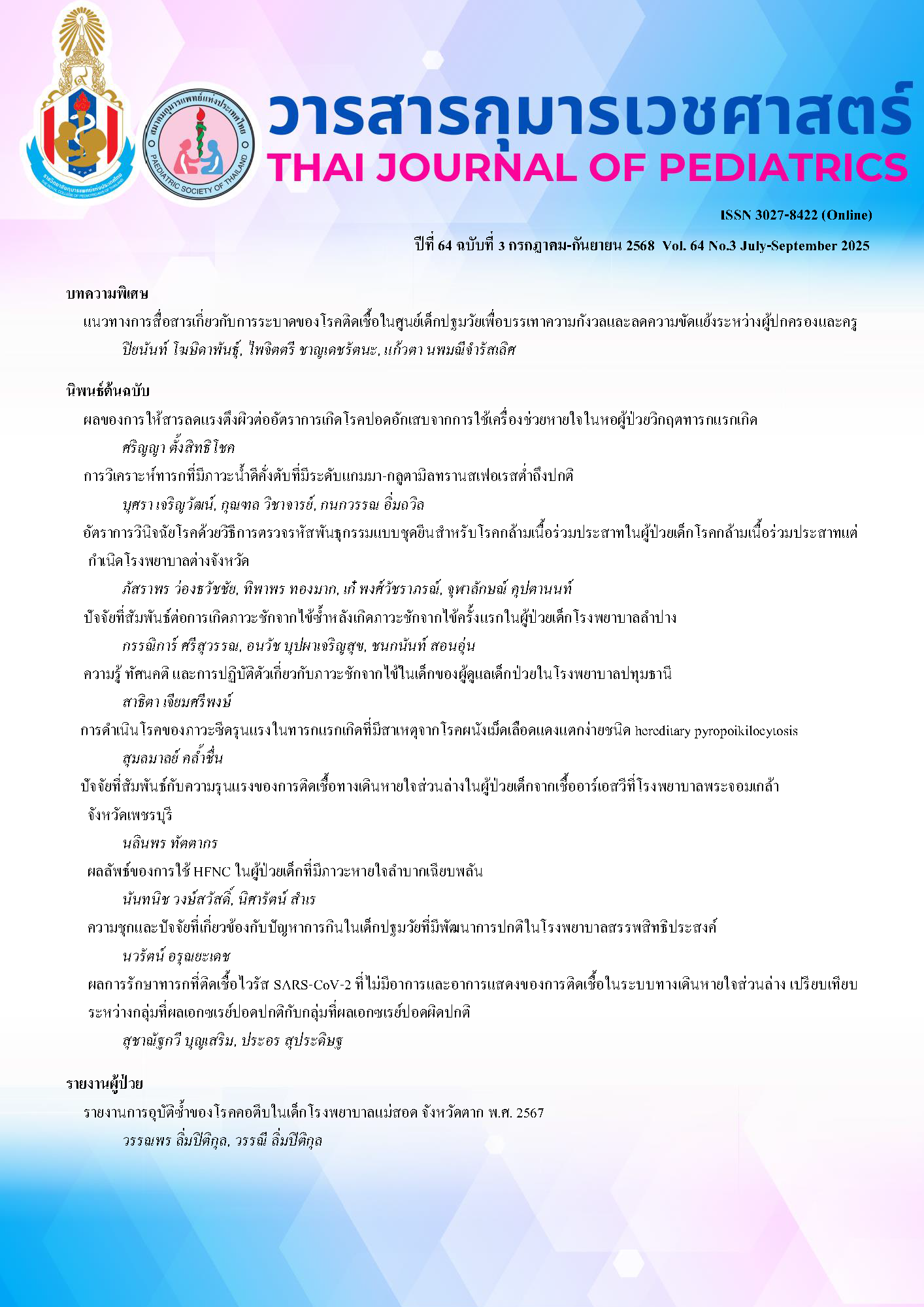Clinical characteristic of severe neonatal anemia caused by hereditary pyropoikilocytosis
Keywords:
Hereditary pyropoikilocytosis, Neonatal anemiaAbstract
Background: This study investigates clinical characteristics of hereditary pyropoikilocytosis (HPP), which causes severe neonatal anemia in patients treated at Sunpasitthiprasong Hospital.
Objectives: To study the clinical features of HPP, which leads to severe anemia in neonates, including diagnosis timeline, mutation types, disease progression, and treatment outcomes, in order to improve diagnostic and treatment strategies.
Method: This descriptive study involved a retrospective review of clinical data from patient records between January 2014 and December 2023.
Results: Of 14 patients, 5 males and 9 females, 64% were preterm. The average birth weight was 1,997 grams. The most common mutation found was homozygous SPTB Buffalo, the SPTB Chiang Mai mutation was not detected. Clinical symptoms included an average hemoglobin level at birth of 5.2 g/dL, neonatal jaundice (100%), hydrops fetalis (7.1%), and respiratory failure occurred in 71.4% of the cases. Among the patients who were diagnosed prenatally and received umbilical cord blood transfusion, 1 out of 3 (33.3%) developed respiratory failure. In contrast, among those who were not diagnosed prenatally and did not receive umbilical cord blood transfusion, 9 out of 11 (81.8%) experienced respiratory failure, persistent pulmonary hypertension of the newborn (35.7%), and hypotension (35.7%). Treatment strategies included fetal transfusion (21.4%), RBC transfusion (100%), phototherapy (100%), exchange transfusion (64.3%) and intubation (71.4%). One patient (7.1%) died from pneumothorax. Of the remaining 13 patients, all had chronic transfusion-dependent anemia, iron overload, hepatosplenomegaly, and cardiomegaly while 84.6% had a weight and height below the age-adjusted average. Other treatments included splenectomy due to hypersplenism in 2 patients (15.4%) and stem cell transplantation in 1 patient (7.7%), which resulted in a cure.
Conclusion: The progression of HPP leads to severe anemia in utero or at birth and can result in death due to respiratory failure. In survivors, regular blood transfusions and iron chelation therapy are necessary. Stem cell transplantation can provide a cure. Prenatal diagnosis and fetal blood transfusion can help reduce the severity of the disease in newborns.
Downloads
References
สุภานัน เลาหสุรโยธิน. ภาวะโลหิตจางในทารกแรกเกิด. ใน: ดารินทร์ ซอโสตถิกุล, บรรณาธิการ. Hematology & oncologic problem in the first year of life. กรุงเทพมหานคร: ทีเอสอินเตอร์พริ้นท์, 2023:38-52.
Chaudhary N, Jassar R, Singh R. Neonatal anemia. Newborn. 2022;1:263-70.
Nassin ML, Lapping-Carr G, De Jong JL. Anemia in the neonate: The differential diagnosis and treatment. Pediatric Annals. 2015;44:159-63.
McEwan A. Fetal anaemia. Obstet Gynaecol Reprod Med. 2021;3:335-41.
Takci S, Gharibzadeh M, Yurdakok M, Ozyuncu O, Korkmaz A, Akcoren Z, et al. Etiology and outcome of hydrops fetalis: Report of 62 cases. Pediatr Neonatol. 2014;55:108-13.
University of Chiang Mai, Department of obstetrics & gynecology. Annual report 2013. Chiang Mai: Chiang Mai University, 2013.
Prasitpaisan N, Somprasit C, Tanprasertkul C, NanthakomonIncidence T. Ultrasonographic findings, and pregnancy outcomes in cases of hydrops fetalis at Thammasat University hospital. Science & Technology Asia. 2022;27:95-103.
Ratarat C, Natesirinilkul R, Sathitsamitphong L, Choed-Amphai C, Fanhchaksai K, Charoenkwan P, et al. Fetal anemia in Northern Thailand: Etiologies and outcomes. Biomed Sci Clin Med. 2024;63:87-93.
Songdej D, Kadegasem P, Tangbubpha N, Sasanakul W, Deelertthaweesap B, Chuansumrit A, et al. Whole-exome sequencing uncovered genetic diagnosis of severe inherited haemolytic anaemia: Correlation with clinical phenotypes. Br J Haematol. 2022;198:1051-64.
An x, Mohandas N. Disorders of red cell membrane. Br J Heamatol. 2008;141:367-75.
DA Costa L, Galimand J, Fenneeau O, Mohandas N. Hereditary spherocytosis, elliptocytosis and other red cell membrane disorder. Blood Rev. 2013;27:167-78.
Andofo I, Russo R, Gamale A, Lolascon A. New insight on hereditary erythrocyte membrane defects. Hematologica. 2016;101:1284-94.
พิมลักษณ์ เจริญขวัญ. โรคเม็ดเลือดแดงในทารกในครรภ์และทารกแรกเกิด. เชียงใหม่: สำนักพิมพ์ ทริคธิงค์, 2021:76-98.
Lux SE. Disorders of the red blood cell membrane. In: Orkin Sh, Fisher DE, Ginsberg D, Look AT, Lux SE, Nathan DG, editors. Nathan and Oski’s hematology and oncology of infancy and childhood. 8th ed. Philadelphia: Elsevier Saunders, 2015:515-79.
Ekwattanakit S, Korchuenjit J, Suksangpleng T, Riolueang S, Taechalertpaisarn T, Parichat Prommana P, et al. An unexpectedly high frequency of SPTB gene mutation (SPTB exon 29: c.6055T>C (p.Ser2019Pro; Spectrin Thai)) with a single origin in Thailand suggesting a new model of red blood cell trait against malarial pressure. Blood. 2018;132:2322.
Ittiwut C, Natesirinilkul R, Tongprasert R, Sathitsamitphong L, Choed-amphai C, Fanhchaksai K, et al. Novel mutations in SPTA1 and SPTB identified by whole exome sequencing in eight Thai families with hereditary pyropoikilocytosis presenting with severe fetal and neonatal anaemia. Br J Heamatol. 2019;185:578-82.
Porter M, Dennis BL. Hyperbilirubinemia in the term newborn. Am Fam Physician. 2002;65:599–606.
Wang J, Ma L, Gong X, Cai C, Sun J. Severe hyperbilirubinemia in a neonate with hereditary spherocytosis due to a de novo ankyrin mutation: A case report. World J Clin Cases. 2021;9:5245-51.
Niss O, Chonat S, Dagaonkar N, Almansoori MO, Kerr K, Rattanpal H, et al. Genotype-phenotype correlations in hereditary elliptocytosis and hereditary pyropoikilocytosis. Blood Cells Mol Dis. 2016;61:4-9.
Ipsaro JJ, Harper SL, Messick TE, Marmorstein R, Mondragón A, Speicher DW. Crystal structure and functional interpretation of the erythrocyte spectrin tetramerization domain complex. Blood. 2010;115:4843-52.
Tachavanich K, Tanphaichitrn VS, Utto W, Viprakasit V. Rapid flow cytometric test using eosin-5-maleimide for diagnosis of red blood cell membrane disorders. Southeast Asian J Trop Med Public Heath. 2009;40:570-5.
Kim Y, Park J, Kim My. Diagnostic approaches for inherited hemolytic anemia in the genetic era. Blood Res. 2017;52:84-94.
ผกาพรรณ เกียรติชูสกุล. ภาวะตัวเหลืองในเด็กแรกเกิด. ใน: สุขชาติ เกิดผล, อวยพร ปะนะมณฑา, จามรี ธีรตกุลพิศาล, ชาญชัย พานทองวิริยะกุล, ณรงค์เอื้อวิชญาแพทย์, จรรยา จิระประดิษฐ์, บรรณาธิการ. วิชากุมารเวชศาสตร์. ขอนแก่น: แอนนาออฟเซ็ตการพิมพ์, 2552:75-90.
นิยะดา วิทยาศัย. Neonatal Cholestasis.ใน: ศรีศุภลักษณ์ สิงคาลวณิช, ชัยสิทธิ์ แสงทวีสิน, สมจิต ศรีอุดมขจร, สมใจ กาญจนาพงศ์กุล, บรรณาธิการ. ปัญหาโรคเด็กที่พบบ่อย 2. พิมพ์ครั้งที่ 3. นนทบุรี: สหมิตรพริ้นติ้งแอนด์พับลิสซิ่ง, 2553:216-32.
Gottesman L, Vecchio M, Aronoff S. Etiologies of conjugated hyperbilirubinemia in infancy: A systematic review of 1692 subjects. BMC Pediatr. 2015;15:192.
พรพิมล โรจนครินทร์. ผลการรักษาและปัจจัยที่สัมพันธ์กับการเสียชีวิตของภาวะความดันเลือดในปอดสูงในทารกแรกเกิด โรงพยาบาลสรรพสิทธิประสงค์. วารสารกุมารเวชศาสตร์. 2021;60:297-304.
Downloads
Published
How to Cite
Issue
Section
License
Copyright (c) 2025 The Royal College of Pediatricians Of Thailand

This work is licensed under a Creative Commons Attribution-NonCommercial-NoDerivatives 4.0 International License.



